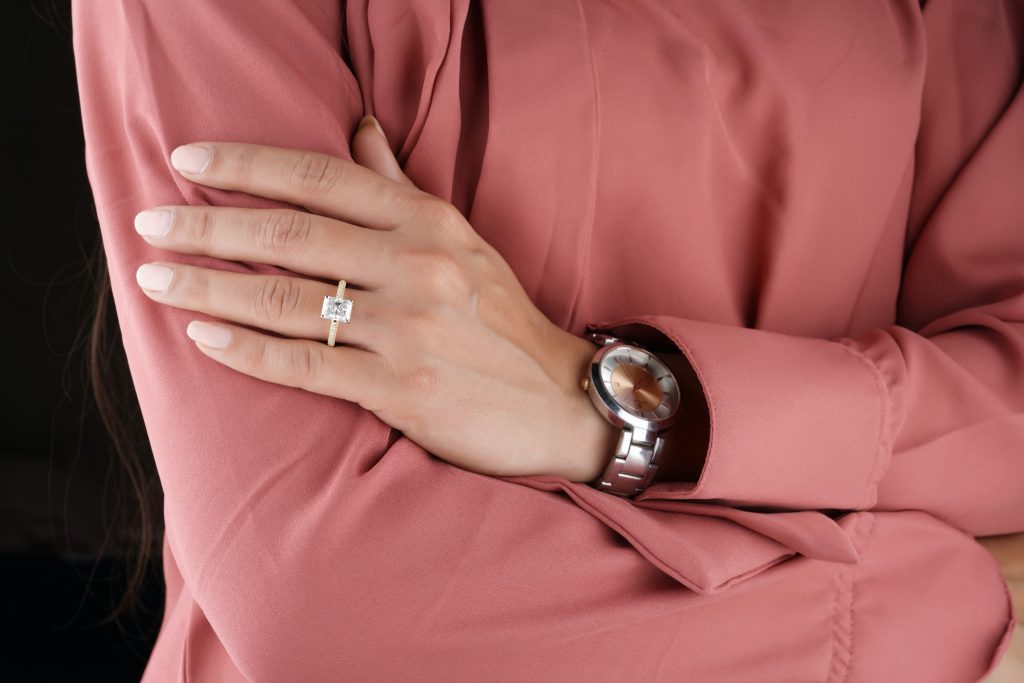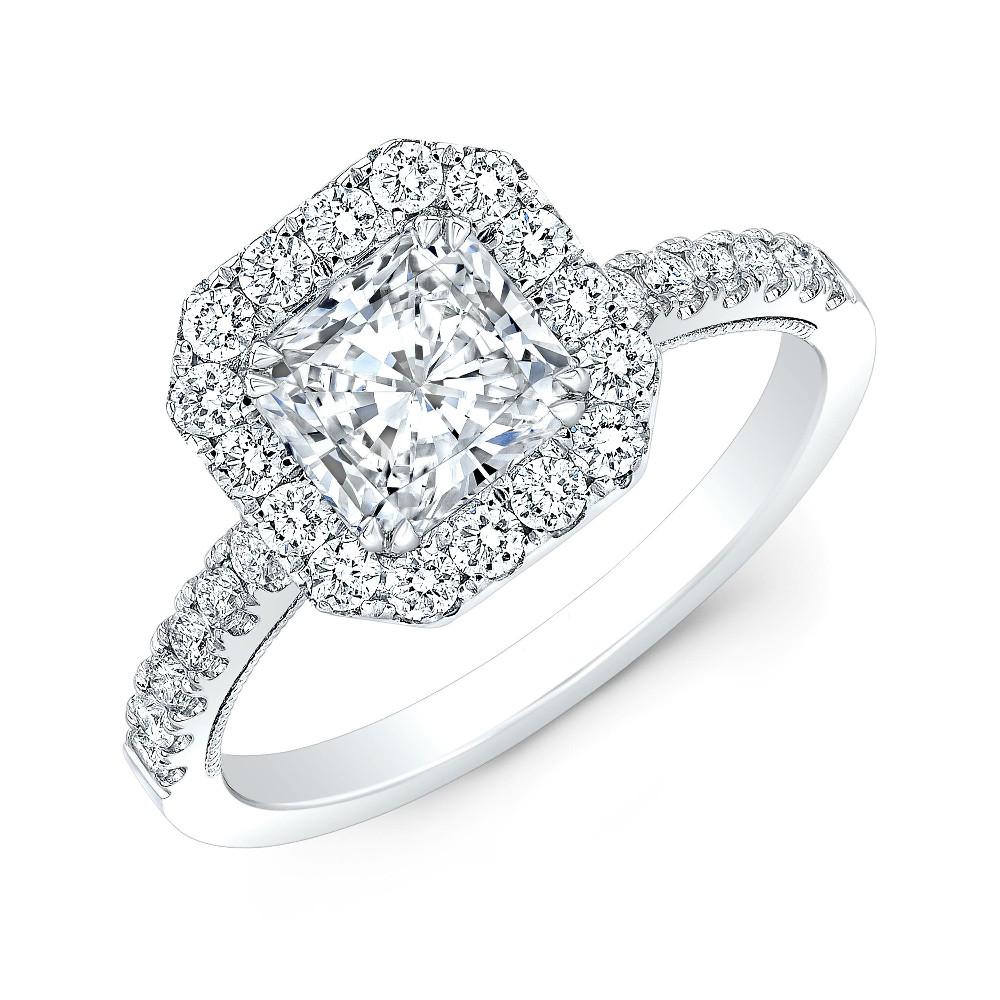What Are Radiant Cut Diamonds?
The radiant cut is a modern diamond shape with no shortage of glamour. This striking brilliance of the radiant cut diamond has made it a favorite among those who favor the bold. If you’re interested in learning more about this rare diamond shape, read on. Below, we’re covering everything you need to know about radiant cut diamonds, including what defines their shape and what you should look for when buying one.
What is a Radiant Cut Diamond?
The radiant cut diamond is a hybrid diamond shape that combines elements of two other shapes: the emerald cut diamond and the round brilliant cut diamond. The radiant cut features the same overall shape as the emerald cut, which is rectangular with cut corners. But while the emerald cut has large step-cut facets, the radiant cut features a modified version of the round brilliant cut diamond’s faceting pattern. This faceting pattern creates dazzling brilliance and radiance, hence the name “radiant cut.”
Radiant cut diamonds are also called “cut corner rectangular modified brilliant” diamonds or “cut corner square modified brilliant” diamonds. These longer, more descriptive names are rarely used by retailers but are standard among diamond grading laboratories like the GIA.
The angular, geometric shape of the radiant cut diamond gives it a bold and contemporary look, but this shape is also considered modern due to its recent invention. The radiant cut was created by diamond cutter Henry Grossbard in 1977, making it one of the newest diamond shapes.

Radiant Cut Diamond Pricing
If you’re looking for glamour and a great deal, a radiant diamond may be your ideal fit. Radiant cut diamonds are among the most affordable fancy diamond shapes because cutting this shape leads to very little rough diamond waste. How much value can a radiant cut diamond offer? A radiant cut diamond can cost 30% to 50% less than a round cut diamond of the same carat weight and quality.
Radiant Cut Diamond Engagement Ring Settings
Radiant cut diamonds look stunning in many engagement ring setting styles, but the most popular is a prong-set solitaire or diamond band setting. Prong settings are most common for radiant cut engagement rings because they allow for the best light entry, which enhances the radiant cut’s impressive shimmer. Bezel settings and halo settings can also be used to create gorgeous radiant cut engagement rings, but they’re simply less popular than sparkle-enhancing prongs.
Radiant Cut Diamond Buying Guide
Choose Your Ratio
The first thing you need to do when shopping for a radiant cut loose diamond is decide what length to width ratio you’re interested in. Unlike most gemstone shapes, the radiant cut can be found in a wide range of proportions. Depending on its length-to-width ratio, a radiant cut diamond can have a perfectly square shape or a very elongated rectangular shape. A 1.0 ratio creates a perfect square, while ratios of 1.15 to 1.35 are slightly elongated and ratios closer to 2.0 are very elongated.
Do you prefer square radiants or rectangular radiants? What length-to-width ratio appeals to you? Decide this first, then focus on quality.

Diamond Quality
There are three main factors that determine radiant cut quality: diamond cut, diamond clarity, and diamond color.
Diamond cut, an assessment of how well a diamond was cut, is always the most important diamond quality because it has a tremendous impact on a diamond’s beauty. If a diamond has a high-quality cut, it will look symmetrical and have excellent light performance. If a diamond has been poorly cut, it will look dull, dim, lifeless, and noticeably misshapen.
Unfortunately, the GIA only gives diamond cut grades to round diamonds, which means you have to evaluate the cut on radiant cut diamonds on your own. You can do this by viewing a diamond in person and by looking for certain cut quality indicators on the diamond’s grading report. Generally, radiant cut diamonds with the best cuts have a table percentage that’s between 61% and 69%, a depth percentage between 61% and 67%, a very thin to slightly thick girdle, and no culet. Radiant diamonds with very good cuts tend to have a very thin to thick girdle, a very small culet, and depth and table percentage that are just a few percentage points outside of the ideal ranges.
Diamond clarity is a grading of how flawless a diamond is. A major advantage of radiant cut diamonds is that their many tiny facets are excellent at hiding flaws. Radiant cut diamonds with clarity grades as low as SI1 can be eye clean, with no flaws visible to the naked eye. You can generally be very flexible with your radiant cut diamond clarity grade and still end up with a flawless-looking diamond.
Your choice of diamond color grade, which tells you how colorless a diamond is, is mostly a matter of personal preference. Radiant cut diamonds show color slightly more easily than other diamond shapes, so don’t go too low in diamond color grade if you want your diamond to look white. Diamond color is graded on a scale of D to Z, with D being completely colorless. If you’re shopping for a diamond for a white gold or platinum setting, an H color diamond or higher is best. If your setting is crafted from yellow gold or rose gold, you may be able to go slightly lower in color, going as low as J color.
Diamond Carat Weight
Once you know what you want for your radiant cut diamond’s proportions and quality, it’s time to consider carat weight. Generally, people simply choose the highest carat radiant cut diamond that they can find within their budget. But if you feel like you can’t get the carat weight and quality you want within your budget, you may need to go a bit lower in carat or quality. If that’s the case for you, be careful about going too low in cut quality just to increase your size. If you go too low in cut quality, your diamond will start to look smaller than it actually is due to a lack of light reflection.
Why Choose a Radiant Cut Diamond?

There’s so much to love about radiant cut diamonds. They’re unexpected, modern, eye-catching, and incredibly brilliant. They’re also an excellent value per carat, making them a wonderful choice for anyone who wants to make sure their budget is used to maximize their diamond’s size and shimmer.
At the end of the day, whether you want a radiant cut diamond or another diamond shape all comes down to personal preference. If you’re still unsure about whether or not a radiant cut diamond is right for you, browse the diamond shape comparisons below to see how radiant cut diamonds stack up against other popular shapes.
Radiant Cut vs. Round Brilliant Cut Diamonds
Radiant cut and round brilliant cut diamonds are both incredibly brilliant. Radiant cut diamonds are the second most brilliant diamond shape, while round brilliant cut diamonds are the most brilliant shape.
Apart from their similarity in brilliance, these shapes are very different. Radiant cut diamonds are angular and elongated, with much potential for variety in their proportions and faceting, while round-cut diamonds are curved, perfectly symmetrical, and have a very specific faceting pattern. This gives radiant cut diamonds a more bold and unexpected beauty, compared to the round diamond’s classic beauty.
Radiant Cut vs. Emerald Cut Diamonds
Radiant cut and emerald-cut diamonds are both rectangular with cut corners, but they feature different types of faceting. Radiant cut diamonds have a shimmery brilliant cut, while emerald-cut diamonds feature long, linear step cut facets that create larger flashes of light. If you’re choosing between these two shapes, the main thing to consider is what type of light reflection you prefer.
Radiant Cut vs. Oval Cut Diamonds
Radiant cut and oval cut diamonds are both elongated and brilliant-cut but are quite different in style due to their overall shapes. The sharp angles of the radiant cut give it a striking glamour, while the soft curves of the oval cut provide a more elegant and traditional look.
Radiant Cut vs. Cushion Cut Diamonds
At first glance, radiant cut and cushion cut diamonds look very similar. Both feature a modified brilliant cut, large tables, and a rectangular shape. The primary difference between these two shapes can be seen in their corners. Radiant cut diamonds have sharply cropped corners, while cushion cut diamonds have rounded corners. This subtle difference has a fairly dramatic impact on each shape’s style. The angular radiant cut looks much more modern and geometric than the softly romantic cushion cut.
Radiant Cut vs. Princess Cut Diamonds
Radiant cut and princess cut diamonds are both sharply angular, with brilliant-cut faceting patterns. These shapes differ in their proportions, corners, and durability. Radiant cut diamonds can range from square to long and rectangular, but princess cut diamonds are almost always perfectly proportional square diamonds. Then, radiant cut diamonds have cropped corners, while princess cut diamonds have uncropped, sharp corners. This difference affects both aesthetics and durability since the thin pointed tips of a princess cut are considerably more prone to chipping.
Radiant Cut vs. Marquise Cut Diamonds
Radiant cut and marquise cut diamonds are both brilliant-cut diamond shapes. They’re also both rare choices, so each provides a unique look. However, they’re quite different in overall shape. The arching, pointed marquise diamond shape is distinctly different from the angular radiant cut. Choosing between these two diamond shapes generally comes down to which unique diamond shape better suits your personal style.


